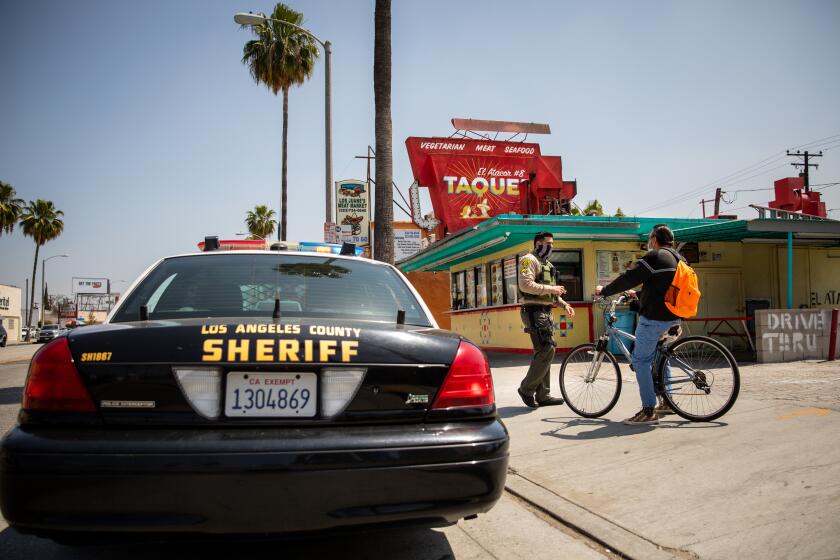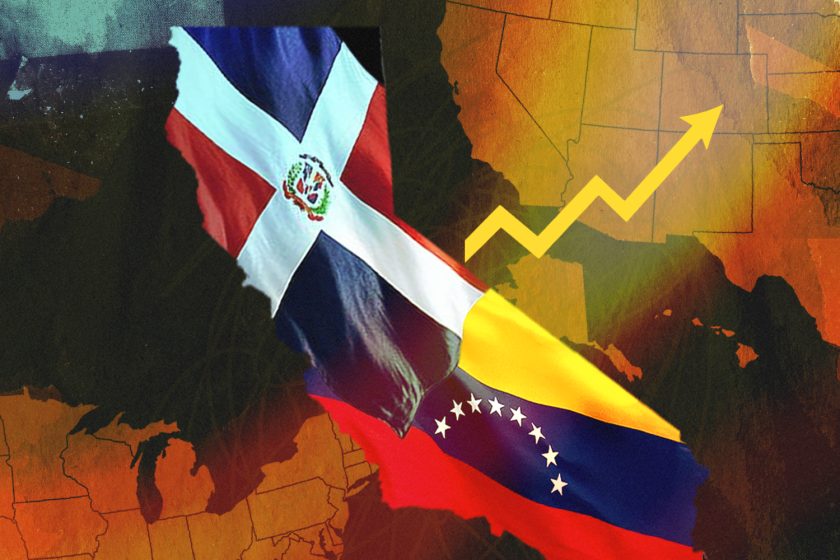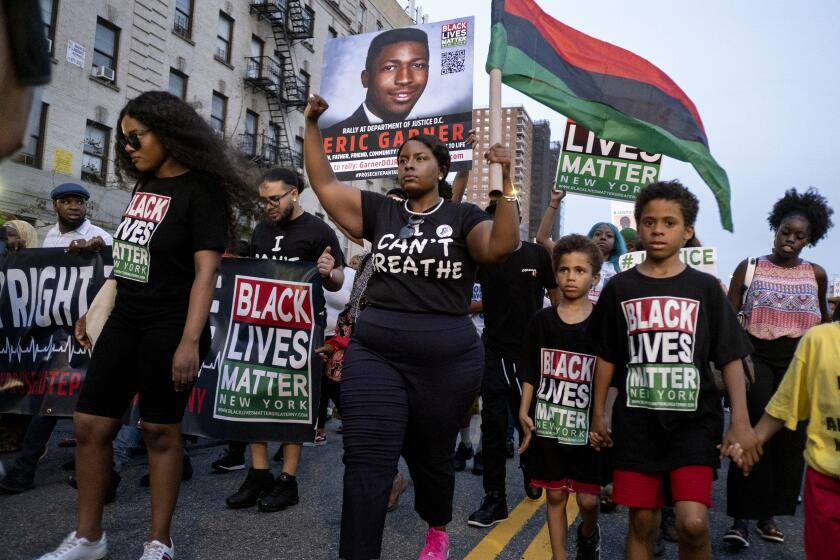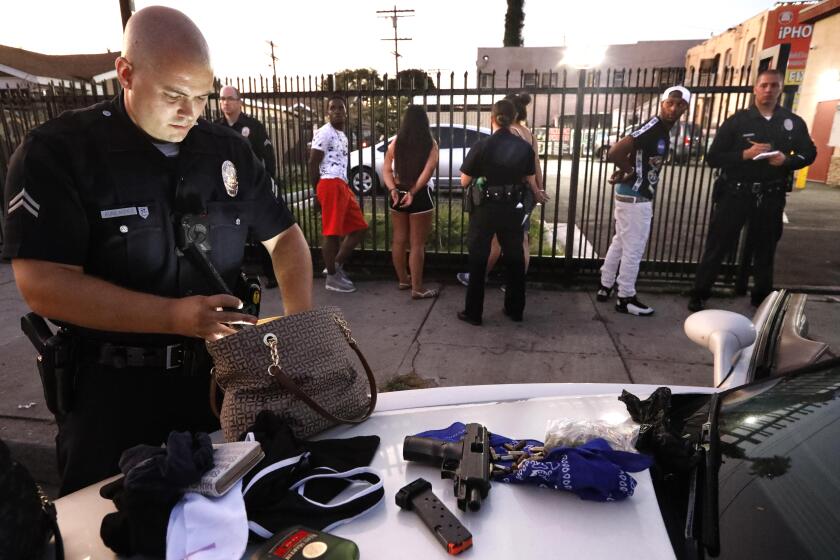Behind L.A. County’s less-scrutinized cities and suburbs, a disturbing finding on arrests

- Share via
Black and Latino populations in three of L.A. County’s northeast cities were disproportionately subject to arrest by suburban police departments, a new report by the county Commission on Human Relations found.
The report analyzed arrest data from 2010 to 2020 from the Glendale, Pasadena and South Pasadena police departments and found large disparities between the rates of arrest for Black and Latino populations versus those of their white and Asian counterparts.
While the Los Angeles Police Department comes under constant scrutiny, departments in the county’s smaller cities are not watched as closely. The report cited as its raison d’être the dearth of public information on police conduct and arrests in small cities and suburban areas.
“Policing in suburban areas is very important. A larger number of people are killed by suburban police officers than urban police officers, but it’s much harder to get info on what’s happening in suburbs, because police have fewer resources in suburbs, and they tend to get less scrutiny than big-city departments,” said Jorgen Harris, an assistant professor of economics at Occidental College and co-author of the report.
The South Pasadena Police Department did not immediately respond to a request for comment, but officials from Glendale and Pasadena suggested that the numbers may have been swayed by the arrest of nonresidents from nearby communities.
One key takeaway, according to Harris, is that while arrests over the last decade have dropped substantially in Los Angeles, the same cannot be said for many smaller cities.
Arrests per thousand residents fell steeply over the past 10 years in South Pasadena, but in Glendale and Pasadena, the number stayed roughly even until the pandemic, when it dropped. Still, Glendale and Pasadena are arresting residents at a much higher rate than Los Angeles and South Pasadena.
“Our understanding of this wasn’t that Glendale and Pasadena have higher amounts of crime than L.A. It’s likely a set of decisions made by police departments about how to respond to crimes that could or could not result in an arrest,” Harris said.
The study found that Latinos made up the largest share of arrests in all three cities — as well as in the city of Los Angeles. This was especially stark in South Pasadena, where Latinos make up less than 20% of the population but accounted for more than 50% of arrests.
In Los Angeles, meanwhile, Latinos make up nearly 50% of the population and accounted for about the same percentage of arrests.
New U.S. census data analyzed by the San Francisco Chronicle show California’s Hispanic populations are changing.
Harris noted that the South Pasadena Police Department does not identify in arrest records whether a person is Latino; it does track white, Black, Asian and “other.” Harris and co-author Seva Rodnyansky compared surnames of those arrested in the city with census data in an effort to determine whether they were Latino.
The disproportionate rate of arrests for Latinos, combined with the fact that the city is not tracking numbers for the group, concerned Harris.
“There’s a very large disparity there, much larger than any of the other cities. That’s a disparity that needs to be measured in order to be understood,” he said.
One reason for the disparity could be that members of large Latino communities near South Pasadena are arrested while driving through the city, Harris conjectured.
In all four cities, Black people made up a higher percentage of those arrested than of the total population, according to the report. Black residents make up less than 10% of L.A. and Pasadena but accounted for more than 20% of arrests.
One study tied police-involved deaths to sleep disturbances and the other found a racial gap in injuries involving police use of Tasers.
On top of the higher arrest rates, Black people were more likely to have a higher cash bail set in their cases, according to the report.
The data for Pasadena showed that bail was set in a similar percentage of cases for all racial and ethnic groups, but the amount varied widely. The median bail for Asians in Pasadena was $5,000; for white people and Latinos, $15,000; and for Black people, $26,000.
In Glendale, the bail disparities were less significant, and Asians had median amounts set at similar levels to Black people.
The report did not provide bail data for South Pasadena.
The report noted that differences in bail amounts could reflect criminal history or specific circumstances of a case and are not necessarily reflective of a judicial decision based on the race of the defendant.
“These differences in bail awards by race could reflect differences in the characteristics of arrestees by race in the number and severity of prior offenses or other characteristics seen by judges and prosecutors, or could reflect implicit or explicit racial bias in the setting of bail,” the researchers wrote.
An L.A. Times analysis found a black person was more than four times as likely to be searched by police as a white person, and a Latino was three times as likely.
The report ruffled the feathers of the Glendale and Pasadena police departments, which noted that a large percentage of those arrested are “transitory,” coming from Los Angeles County but not necessarily from within the cities.
The Glendale Police Department said it appreciated the commission’s efforts in conducting the analysis and recognizes “the importance of transparency and accountability in law enforcement practices.”
But the department cited numerous issues with the study, including the fact that it was not consulted.
Glendale’s police department said that its arrests closely mirror demographic data for the county.
“It is imperative to note that over half of the arrests made in Glendale involve nonresidents, underscoring the importance of considering regional dynamics when interpreting arrest statistics,” the department wrote in response to the report.
The civil liberties group said police across the state use K-9s to inflict ‘unnecessary, disproportionate harm on people’ who commit minor crimes, and that bystanders and ‘people experiencing a behavioral health crisis’ have also been attacked.
The Pasadena Police Department noted a similar phenomenon, saying the report did not account for “the increased transitory population” in the city during the daytime and during events that lead to greater numbers of arrests of nonresidents.
Helen Tran of Care First South Pasadena said the public safety activist group sent a report with similar data to the city’s police department in 2022. South Pasadena did not give a meaningful response to the data at the time, she said.
“We want the city to actually take action on the data, not just sit there and have data to look at,” Tran said.
More to Read
Sign up for Essential California
The most important California stories and recommendations in your inbox every morning.
You may occasionally receive promotional content from the Los Angeles Times.
















